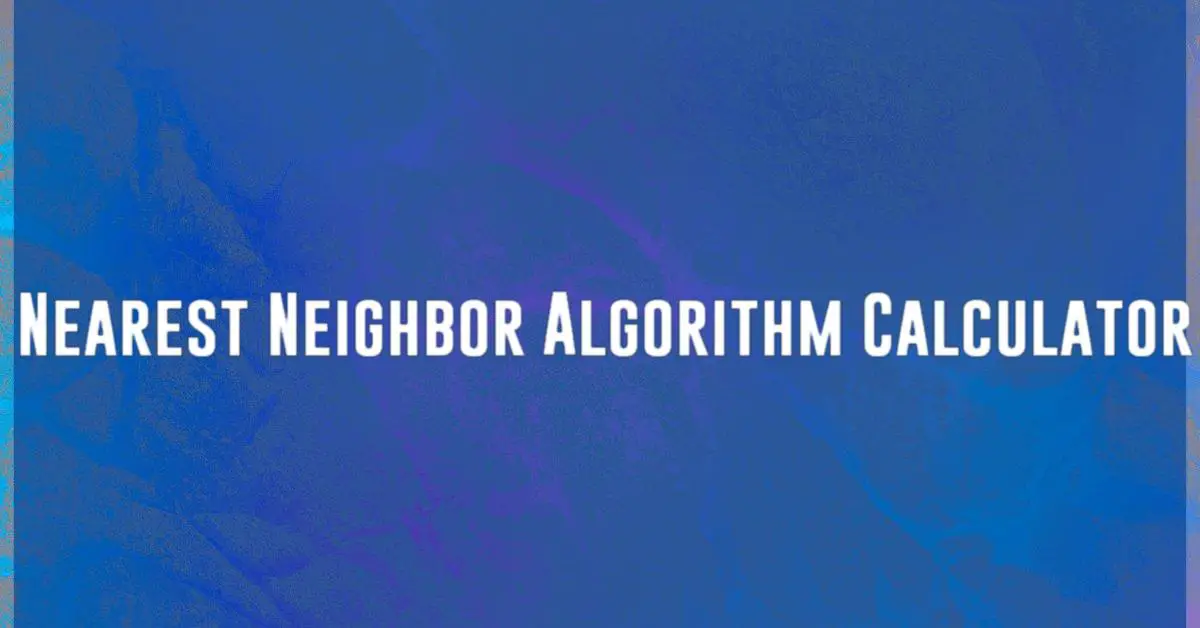What is a Nearest Neighbor Calculator?
A Nearest Neighbor Calculator is a tool that helps find the closest neighbors of a particular data point based on a given distance metric. This tool is commonly used in data analysis, machine learning, pattern recognition, and image processing to identify similar objects or patterns in a dataset. By calculating the distances between data points, the Nearest Neighbor Calculator can provide valuable insights into the relationships within the dataset.
| Item | Details |
|---|---|
| Number of Points | |
| Distance Metric | |
| Nearest Neighbor Distance |
How Does a Nearest Neighbor Calculator Work?
The Nearest Neighbor Calculator works by taking a dataset with multiple data points and a query point as input. It then calculates the distance between the query point and all other points in the dataset using a specified distance metric, such as Euclidean distance or Manhattan distance. The calculator then ranks the data points based on their distance from the query point and returns the k-nearest neighbors, where k is a user-defined parameter.
One of the key advantages of using a Nearest Neighbor Calculator is its simplicity and efficiency in finding similar data points. This makes it a valuable tool for various applications, including clustering, classification, anomaly detection, and recommendation systems.

Applications of Nearest Neighbor Calculators
Nearest Neighbor Calculators have a wide range of applications across different industries and fields. Some common applications include:
1. Recommender Systems
Nearest Neighbor Calculators are often used in recommender systems to suggest products, services, or content based on the preferences of similar users. By finding the nearest neighbors of a user’s behavior or preferences, these systems can provide personalized recommendations that are tailored to individual tastes.
2. Image Recognition
In image processing and computer vision, Nearest Neighbor Calculators can be used to identify similar images or patterns within a dataset. This technology is commonly used in facial recognition, object detection, and image retrieval systems to match images based on their visual features.
3. Anomaly Detection
Nearest Neighbor Calculators are also valuable in detecting anomalies or outliers within a dataset. By comparing the distance of each data point to its nearest neighbors, this tool can identify unusual patterns or data points that deviate significantly from the norm. This is particularly useful in fraud detection, network security, and quality control applications.
4. Clustering and Classification
Nearest Neighbor Calculators are commonly used in clustering and classification tasks to group similar data points together or assign labels to unlabelled data. By finding the nearest neighbors of each data point, this tool can separate data into different clusters or predict the class of a new data point based on its neighbors.
Benefits of Using a Nearest Neighbor Calculator
There are several benefits to using a Nearest Neighbor Calculator in data analysis and machine learning tasks:
1. Simple and Intuitive
Nearest Neighbor Calculators are easy to understand and implement, making them accessible to users with varying levels of expertise. The concept of finding nearest neighbors is intuitive and can be applied to a wide range of datasets and problems.
2. Scalability
Nearest Neighbor Calculators are scalable to large datasets and can handle high-dimensional data effectively. This tool is suitable for processing massive amounts of data and can be optimized for performance in real-time and batch processing scenarios.
3. Versatility
Nearest Neighbor Calculators are versatile and can be adapted to different distance metrics, algorithm variations, and parameters. This flexibility allows users to customize the tool for specific use cases and optimize its performance for varying dataset characteristics.
4. Interpretability
Nearest Neighbor Calculators provide transparent and interpretable results, making it easy to understand how the nearest neighbors were selected and why they are considered similar to the query point. This transparency is essential for building trust in the model and making informed decisions based on the results.
Conclusion
A Nearest Neighbor Calculator is a powerful tool for finding similar data points within a dataset and extracting valuable insights from the data. With its simplicity, efficiency, and versatility, this tool has applications across various industries and fields, making it an essential component of data analysis, machine learning, and pattern recognition tasks.
Whether you are building recommender systems, detecting anomalies, clustering data, or performing classification tasks, a Nearest Neighbor Calculator can help you uncover patterns, relationships, and trends that might otherwise go unnoticed. By leveraging the power of nearest neighbors, you can enhance the accuracy, efficiency, and reliability of your data analysis and decision-making processes.






